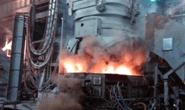Scrap Prices North America

Mills to Pass Along the High Cost of Electrodes
Written by Tim Triplett
June 5, 2018
High graphite electrode prices will soon start to show up in the price of steel, reports West Coast scrap exporter Damon Sun of Daido International, who offers the following observations on the market:
“The Asian markets will likely take a back seat to U.S. scrap as mills start adjusting for the extremely high graphite electrode prices. In the past, there was a general formula from steel scrap to finished steel products of about $200-$220/mt melt and rolling costs. With the high graphite electrode prices, the increase in production is $50-$60/mt with a total variable cost of steel production from $200-$220 to $250-$270/mt. It is a substantial increase with EAF mills now focusing on prolonging the useful life of these electrodes.
“Graphite electrodes for the mills tend to be purchased on a contract basis. The rapid increase in graphite electrode prices started in August 2017. Therefore, even yearly contract prices should expire at summer’s end and thus these cost components should be reflected in every mill’s prices by fourth-quarter 2018.
“The recent graphite electrode surcharges are just the beginning of the impact on steel. The other impact involves the scrap mix. In order to prolong the useful life of these electrodes, mills want to melt higher grade, denser and cleaner steel scrap. That’s the reason the higher grades will be more in demand, while mills will tend to limit the HMS grades from their melts. Certain grades that are lower in quality and chemistry than HMS will also be limited. Gerdau Monroe is one example of an EAF mill that’s limiting HMS grades.
“Price differences between high grades and HMS and lower grades are widening. Recent bids by Hyundai steel in Korea show this widening gap. For Japan H2 grades, the recent price bids were 1,000 yen lower, while higher grades were 1,000 yen higher.
“In any case, finished steel prices in Asia have not fully adjusted for the graphite electrode costs yet, partially due to staggered contract prices on the electrodes. Moving forward, mills are working on lowering scrap prices and raising finished steel prices concurrently to reflect these costs. These adjustments globally will take some time, but should be fully reflected by Q4 2018.”

Tim Triplett
Read more from Tim TriplettLatest in Scrap Prices North America

HRC vs. scrap spread widens over $150/ton in March
The HRC vs. prime scrap spread increased again in March.

HRC vs. prime scrap spread increases in February
The price spread between hot-rolled coil (HRC) and prime scrap widened in February ahead of the implementation of President Trump’s tariffs on steel.
HRC vs. prime scrap spread narrows again in January
The price spread between hot-rolled coil (HRC) and prime scrap continued to narrow in January, according to SMU’s most recent pricing data. While SMU’s average HRC price edged down week over week (w/w), it rose compared to a month ago. The January price for busheling also increased from December. Our average HRC price as of […]

HRC vs. prime scrap spread flat in November
The price spread between hot-rolled coil (HRC) and prime scrap remained the same in November as both tags were at the levels seen a month earlier, according to SMU’s most recent pricing data.

HRC vs. busheling spread narrows slightly in October
The price spread between hot-rolled coil (HRC) and prime scrap narrowed marginally in October, according to SMU’s most recent pricing data.
